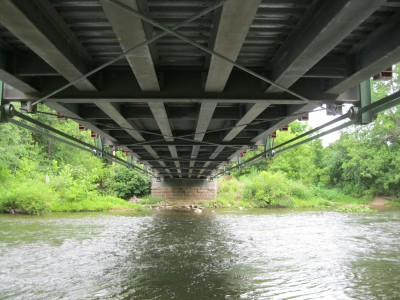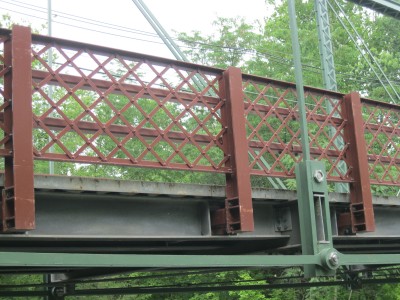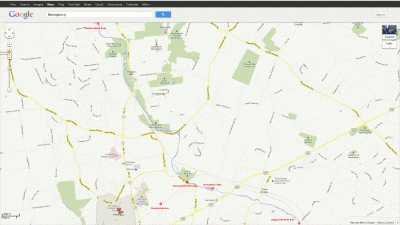
Double Secret Zombie Engineering
Another pic of the Fryer’s Ford bridge: http://www.flickr.com/photos/28579340@N08/5611817076/
Other pics of the Rockafellows Mills Bridge I uploaded but may not have put in the post
http://www.barking-moonbat.com/images/uploads/old_hunterdon_bridges_176.jpg another portal view of the bridge, showing the fancy bits on top nicely.
http://www.barking-moonbat.com/images/uploads/old_hunterdon_bridges_193.jpg lower chord connection showing the arch made by the deck beams
http://www.barking-moonbat.com/images/uploads/old_hunterdon_bridges_196.jpg the foot of the bridge - is it mounted on rubber blocks??
http://www.barking-moonbat.com/images/uploads/old_hunterdon_bridges_203.jpg detail of modern guard rail showing how “pretend” original lattice was fit in.
http://www.barking-moonbat.com/images/uploads/old_hunterdon_bridges_183.jpg detail of restored end post connections. 100+ years of welded on plates and bits removed. Compare to the pics at Nathan’s RMB page
http://www.barking-moonbat.com/images/uploads/old_hunterdon_bridges_184.jpg upper chord wind and sway bracing details
http://www.barking-moonbat.com/images/uploads/old_hunterdon_bridges_189.jpg non-original: bolts replace hundreds of the original rivets. They’re stronger, and once painted it’s hard to spot them.
http://www.barking-moonbat.com/images/uploads/old_hunterdon_bridges_185.jpg a view upstream: the mill pond remains but the mill is long gone. The water tower just above the treeline in the middle of the picture is the one on County Route 523/Walter E. Foran Blvd, about 200 yards east of Route 31. So it might look like you’re deep in the country here, but “civilization” is just two turns and half a mile away. The water tower is part of the former Nestle factory, where they used to make Snapple drinks. Yale owned it too, and then they left as well.
Another one of my local bridge spotting posts. The Rockafellows Mills Bridge is a Pratt through truss, built in 1900. It’s only 3 miles away from the bunch of local bridges I wrote about the other day. Click any of the pictures for much larger versions.
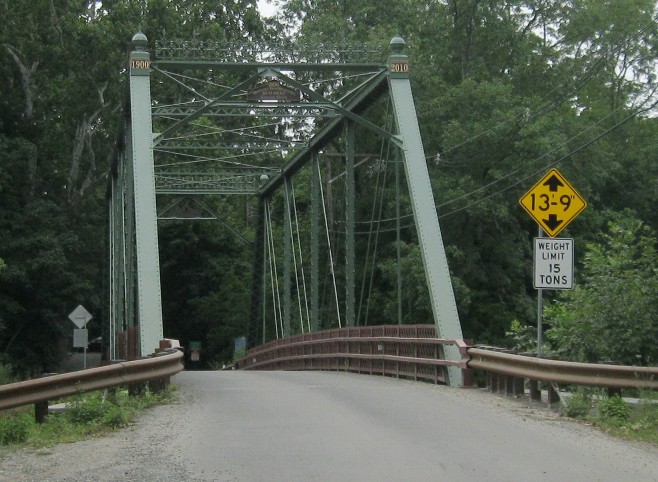
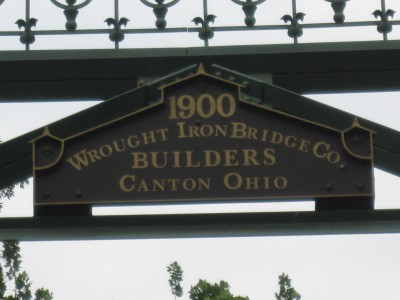
At the turn of the 20th Century, the Wrought Iron Bridge Company of Canton Ohio was going gangbusters. There were building bridges everywhere across America. They had developed a line of cost effective and reliable steel bridges that were easy to assemble and maintain, and towns and states were lining up to give them business. There wasn’t much of any truck or car traffic in those days; the world still ran on horses. But what there was, was thousands of poorly made, rotting, old wooden bridges nearing the end of their useful lives. And it was the Iron Era, so it was time for the wood ones to go.
Hunterdon County NJ bought several bridges from these guys. We still have most of them. The Rockafellows Mills bridge above is practically a kit bridge. It’s 140 feet across and about 18 feet wide. It’s a one lane job, and could handle a 3 ton load. It was put together with pins and rivets: no welding. It was the “Chevy Malibu” of it’s day: plus or minus some decoration, this bridge had hundreds of sisters all across the country. Here’s pretty much the exact same bridge in Arkansas:
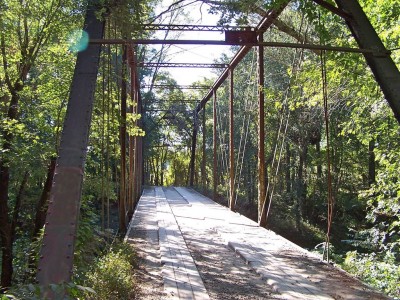
So what’s the big deal? Their bridge is dead. Ours is in glowing health.
And double secret zombie engineering is going to keep it that way.
Ok Drew, WTFF is “double secret zombie engineering”? It’s a special hitherto unknown bridge builder’s term that I just invented, that describes the hidden art of shifting the load from the dead to the live. Get a load of that.
More below the fold, including a redneck Pratt-fall.
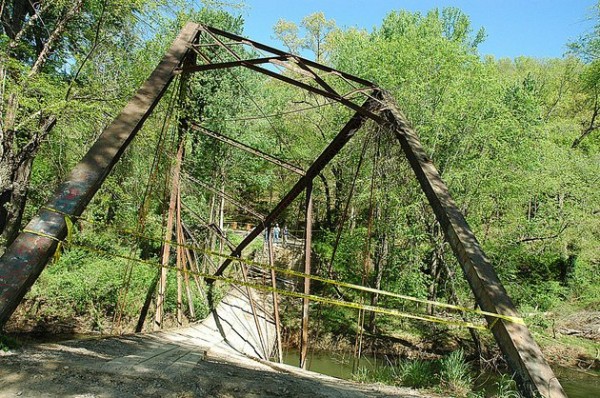
April 13, 2011: 9-ton truck pulls down 1890s span
Travelers spanning three centuries - first ones on foot, then in covered wagons or on horseback, recent ones in cars, vans and pickups and finally one in a 9-ton truck - have crossed Fryer’s Ford Bridge in rural Conway County.
Until this week, the iron-truss structure built in 1890-91 over Point Remove Creek that is also known as the Solgohachia Bridge was Arkansas’ oldest bridge still in service.
That changed Monday, when the bridge was yanked from its foundation when a tall water reel that the heavy rig was pulling got caught on a clearance bar, County Judge Jimmy Hart said Tuesday.
...
Authorities said Jason Burris, 34, of Russellville was driving the 9-ton truck when the accident happened Monday.He was ticketed for disobeying a traffic-control device - signs prohibiting commercial trucks from using the bridge, which only vehicles up to 3 tons could legally cross.
I think this story is half moonshine. You can see in the first picture of the Fryer that the bridge was in poor shape. Not just the rust, but the snapped hip vertical eyebar on the right hand side. And I’m not buying the “yanked from it’s foundations” bit either. One, these things are generally bolted down. Two, if something on the trailer snagged the clearance bar, it means the whole truck was already on the bridge. Less “tow truck” pulling action that way. Three, clearance bars are supposed to break away, and if you compare the two pictures under the portal bracing (the metal across the end of the bridge) you can see that the rusty old clearance bars are gone. They’re the thin horizontal bars with the small rusty rectangles on them. At least one did it’s job. No, what killed the Fryer was a 9+ ton load on a <3 ton rated bridge. I say ”<3" because of it's degraded condition. Even though good engineers tried to build these things to triple their rated strength, rust and neglect will wear that strength down considerably. And when you go over the limit ... snap.
And the Pratt fell. No one was injured, but the bridge is done.
Nathan Holth over at historicbridges.org did his usual superb job of documenting the Rockafellows Mills bridge. He came by in 2008 before the renovation, and the county was kind enough to provide him with some cool pictures taken during the renovation. He’s a gen-yoo-wine expert, so it’s cool for him to quibble about whether or not the decorations were original, and how he thinks the old railing should have gone back up instead of a newly made one. I just think the result is gorgeous. And quaint. We do quaint around here at the professional level, because it adds to the real estate values, and helps people to not notice the outrageous property taxes they have to pay to live here. And it’s not like we didn’t have several other old Wrought Iron Bridge Company bridges to borrow decorative bits from, or use those to cast up some new ones and bolt them on.
I’ve got to go to work now, but when I get back I’ll post a bunch of pictures and explain my theory about how the bridge became so much stronger. Basically, to paraphrase that old breath mint jingle, “It’s two, two, TWO bridges in one!” And you can compare his pre-renovation pics to my post-renovation pics, and decide if you like the differences or not. (Saturday 6:20 pm) If you don’t feel like waiting, compare our bridge with the Fryer’s Ford bridge. If you can see the difference - and no, it’s not in the decorations or the guard rail - and you can see it - then you’ll have it at least halfway figured out before I get back.
Ok, back. (10:20pm)
double secret zombie engineering, Secret 1
Over on YouTube, there is a homemade video of the Fryer’s Ford bridge once it had collapsed. The camera is a bit wobbly, but I’m pretty sure that the end of the bridge in the video has both of the right side hip vertical eyebars in place. You can see that the collapse happened at the other end of the bridge, which would be the end in the above photograph; the one with the snapped vertical. Ooops. The whole bridge is pretty ripped up, and around the 50 second mark you can that the end of the decking has pulled up from the abutment. Here:
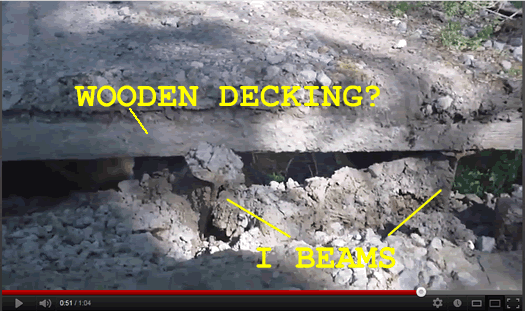
Looks like 8” I beams placed about 36” apart. Pretty thin ones too. 4” wood planks over them running side to side. And then a few inches of asphalt over that. It’s probable that the asphalt layer is much younger than the bridge. And it’s just as probable that the wood planks were replaced at some point, or even every couple of decades. But the little beams, widely separated, appear to be the originals. In other words, there isn’t a whole lot of stuff down there to carry the load. Compare that to what the renovators put under the Rockafellows in 2010:
It’s hard to get a sense of scale here in this picture taken underneath the bridge. The roadway is about 15 1/2 feet wide, and the bridge is about 17 feet wide from chord pin to chord pin. I didn’t bring a ruler, but what you’re looking at is serious steel. 12” beams? 14s? Hefty stuff. The deck plating is 1/4” corrugated steel sheets, which are then filled with asphalt.
This side view of part of the lower chord gives you a better idea of the size. Freakin Solid is the technical term I think. Notice how the lower end of the verticals ( an eyebar in this case ) has been modified to take the even larger cross beams that the stringers are welded to.
Ok, so under the deck there is lots more steel and it’s all brand new. But while that can support much more of a load by itself, it also weighs probably twice as much as what was under the Fryer’s. And since this was originally a 3 ton load bridge, and they’ve just added several tons of extra steel, how can it have any load rating at all? Seems like the bridge should be about ready to blow apart, without even so much as a pigeon sitting on it. Forget cars or small trucks.
ENTER THE ZOMBIE ENGINEERS, aka “Bring out your dead!”
The amount of weight that a bridge can support is called it’s load. The load is divided into two parts: the dead load and the live load. The dead load is the weight of the bridge itself, including the roadway. The live load is the additional weight that the bridge can support. This is the value that you see on the signs; “load limit 3 tons”, “load limit 15 tons”, etc. Supporting that load is a form of work. Good engineering calls for bridges to be built strong enough to carry at least 3 times their rated live load.
I’m having a bit of fun with the “zombie” label, because my wild imagination sees the dead working here, and the hidden redesign that shifted so much of that work to the “live” or living as some kind of labor negotiation. Plus the mental picture of a bunch of zombie engineers marching around, slide rules and pocket protectors, chanting “statics! statics!” makes me laugh. Besides, engineers already have more brains then necessary, so their zombie counterparts would be in search of some other sustenance. And the study of statics is pretty much what truss bridges are all about.
I was going to write a bunch of paragraphs here that would bore you to tears, tell you all about the design of old wooden bridges and railroad trestles, tell you all about dynamic loading, and show you this combination bridge design called a Burr Truss. Instead, I’ll just throw in a bunch of links, and hope that those and the pictures will support my thesis. So here it is:
double secret zombie engineering, Secret 2
The roadbed of the Fryer’s Ford bridge was original, and pancake flat. The roadbed of the Rockafellow’s Mills bridge before renovation was pancake flat. The roadbed of that bridge after renovation has a noticeable arch to it. When they fixed the bridge, they also rebuilt the abutments. An arch can support far more weight than a flat beam, as long as it’s ends are supported so that it can bow in and expand laterally. This is what was done. An arch doesn’t have to be a smooth curve to work either. It can be made of short straight sections; this is a polygonal arch. Ta da!
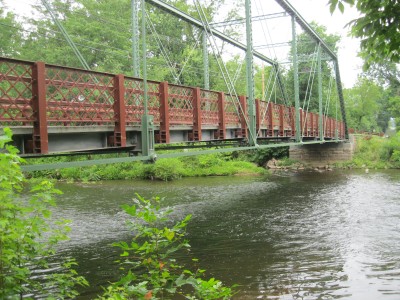
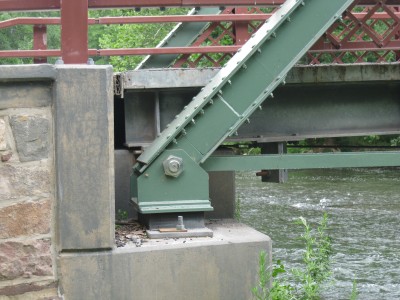
So there it is. The roadbed is a long low elliptical arch, and it rests directly on the strengthened abutments. This means that the antique truss bridge really doesn’t carry any of it’s weight. All the truss does is help support the arch when necessary. So a “3 ton” bridge that was previously also supporting a 5 ton roadbed is now an “8 ton” bridge (or so) because it isn’t supporting any roadbed at all. And the roadbed, now made really strong and in an arch, can support a live load of 7 or so tons all by itself. 8+7=15. And the dead stop being such a burden and the live can now do all the work. All because of two hidden modifications that you’ll never see when using the bridge, or never even notice unless you know what to look for when visiting the bridge as a tourist.
And the old lady is now just as pretty as ever, all dolled up and ready to face another century. Double secret zombie engineering. It works!
Here’s a map in case you want to visit. There are 4 more bridges in this area to see, two of them double bridges. This section of Hunterdon County is about 3 miles further south on Route 31 than the area I wrote about the other day. By car you can see all of them in a day; Hunterdon is about an hour west of New York City and about an hour north east of Philadelphia.
Drew you may not get many responses on these articles, but I for one find them really interesting.
Posted by LyndonB 07/16/2012 at 11:54 AM
07/16/2012 at 11:54 AM

Thanks. I know they take too long to read, and too long to load the giant pictures. And 19th Century engineering - or any engineering at all - isn’t interesting to most folks. But I love it. Being around these old bridges makes me feel like I’m 7 years old again, in awe of how wonderful and exciting the world is.
It’s all been stress relief for me, since 3 members of the immediate family are in terrible health situations right now. Well, 2, since my sister in law’s mother in law just died, after a long debilitating illness caused by incurable lung fungus. She was 82. Not sure what the funeral plans will be if any; she was both English and agnostic. And usually quite caustic in my direction; we weren’t close at all. Her son’s condition might finally be on the mend, and my MIL is now out of the hospital and in a physical therapy center. So that’s also an improvement. But it’s been ... very stressful ... around here the past month or so. I’ve used bridge spotting as an escape.
Posted by Drew458 07/17/2012 at 08:47 AM
07/17/2012 at 08:47 AM
 Commenting is not available in this weblog entry.
Commenting is not available in this weblog entry.
Next entry: Free Health Care
Previous entry: at least on this issue .... President Putin has it right
